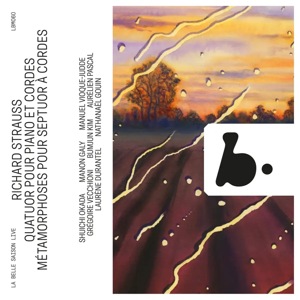
Richard Strauss (1864-1949)
Piano Quartet in C minor, Op. 13, TrV 137 (1885)
Metamorphosen, Trv 290 (1945)
Trio Arnold
Manon Galy (violin), Grégoire Vecchioni (viola), Aurélien Pascal (cello), Laurène Durantel (double bass), Nathanaël Gouin (piano)
rec. live, 3 November 2023, Théâtre de Coulommiers, Seine et Marne, France
B Records LBM060 [67]
Metamorphosen is one of Strauss’s finest works and also the only which is at all introspective. He started writing it towards the end of the war, particularly affected by the destruction of Dresden and of the opera houses in which much of his work had been presented. But it surely has a wider meaning than that: it is not only a lament for the destruction of German culture but also, suggests Michael Kennedy in his Master Musicians volume on the composer, a personal apologia for having had anything to do with the Nazi regime at any time. Although it is basically a threnody, it does vary in mood and tempo. Towards the end it turns out that it has been based on a theme from the Funeral March of Beethoven’s Eroica symphony, which is quoted at the end with the words In Memoriam in the score.
Strauss originally started drafting it as a chamber work, but enlarged it when he received a commission for a work for strings from the Swiss impresario Paul Sacher. He then scored it for twenty-three strings, and this is the standard version, although Karajan used to expand the scoring to thirty-six players. The standard version has been recorded many times, and here I refer readers to Ralph Moore’s survey of recordings.
However, in 1990 a short score of Strauss’s original version was discovered. This is scored for string sextet, that is, pairs of violins, violas and cellos, plus a double bass. This was edited for performance by Rudolf Leopold, published and has now been recorded a few times. That is the version we have here. The musical substance is basically the same but there are some differences. For example, the opening in the standard version is for five cellos and three double basses. In the septet version this is played by two violas, two cellos and one double bass. Some of the internal counterpoint is also omitted and the modulation at the end is slightly different. However, these differences are really quite minor, and the work can be enjoyed in either form. In this we may contrast it with Schoenberg’s Verklärte Nacht, written indeed at the beginning rather than the end of its composer’s career, ecstatic rather than melancholic, and for which the chamber version, for string sextet, is the original, and the string orchestra the later arrangement, this time by the composer. The two make an obvious and appropriate pairing.
There are two particular difficulties in performing Metamorphosen. The extreme beauty of the themes tempts the ensemble to play too slowly, particularly in the opening Andante section, which risks the work becoming lugubrious. The other is that Strauss writes in constantly interweaving polyphonic lines, and it is important at any one time to be clear who has the theme and who has secondary material. This performance, by the expanded Trio Arnold, does not wholly escape either of these weaknesses, attractive and moving though their performance generally is. These are live recordings, in a suitable acoustic, and applause is included.
Then there is the issue of what to choose for a coupling. Trio Arnold have chosen Strauss’s early piano quartet, No one would guess that this was by Strauss. Most of it sounds like pastiche Brahms, though the scherzo is quite witty and the finale at one moment seems to anticipate Piazzolla. It is clearly quite challenging for the players, but this does not make it especially rewarding for the listener, and I doubt whether it will often be played.
There are some other recordings of Metamorphosen in its septet form. The Nash Ensemble on Hyperion bring a nervous intensity to it, and also resist the temptation of relishing the melodies too much. They have the Piano Quartet but also the Prelude to Capriccio, written for string sextet and another late work which makes a good foil to Metamorphosen. However, the enlarged Brandis Quartet on Nimbus, consisting of players from the Berlin Philharmonic, have the best of both worlds, with both the Capriccio prelude and Verklärte Nacht as their couplings. Ralph Moore chose the Brandis as the best recording of Metamorphosen in its septet version and I am happy to concur.
Stephen Barber
Previous review: Ralph Moore (April 2024)
If you purchase this recording using a link below, it generates revenue for MWI and helps us maintain free access to the site




















